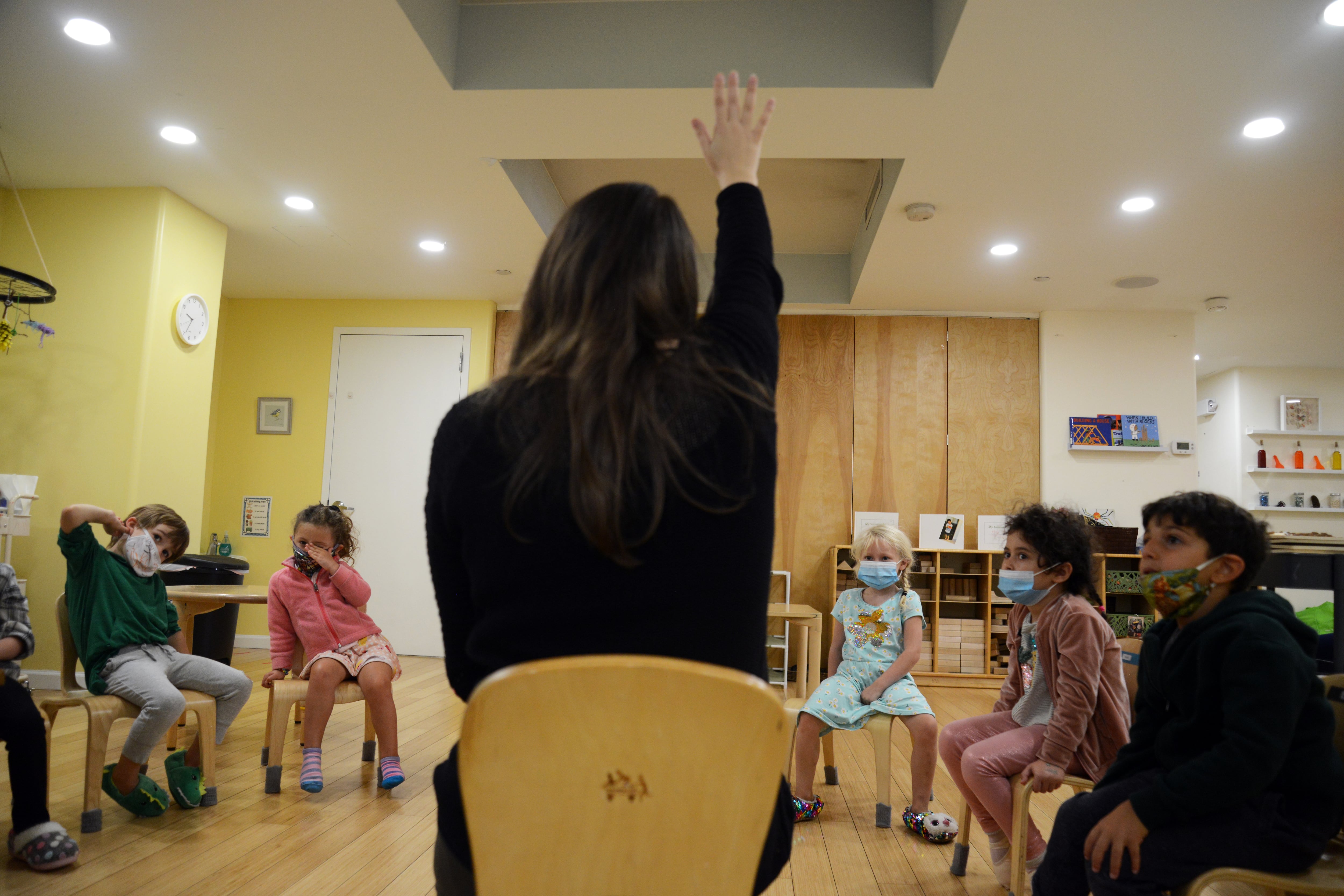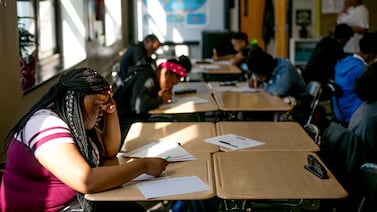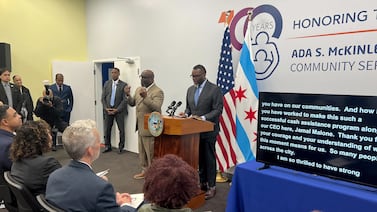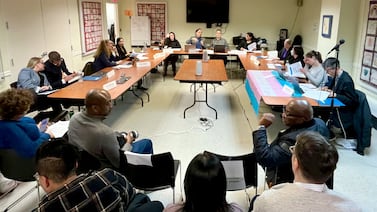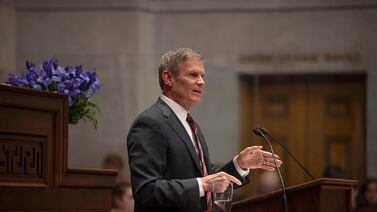As a preschool teacher who might be among the first educators to return under Chicago Public Schools’ reopening plan, Karina Cuncul’s questions involve subjects that officials don’t typically discuss.
How do you keep your distance when a small child needs help in the bathroom or wiping their nose? What do you tell a 3 year old who wants a hug?
And what about the toys — the Play-Doh and sensory bins and building blocks. Are the staples of a preschool classroom now relics of a pre-pandemic era?
“We teach through play. If they can’t use the toys, the classroom will look really different. How can I keep them engaged?,” asked Cunculs, who teaches at an early childhood center in the McKinley Park neighborhood on the city’s South Side.
There’s no return date yet, but Chicago Public Schools has told preschool teachers they’d be among the first to return to classrooms as it gets ready to phase in classroom learning by grade. With the union that represents them opposing the plan, which union leaders argue was developed without their input, teachers described feeling anxious and conflicted even as they acknowledged enrollment drops and problems with remote learning.
Safety is educators’ top concern, but hesitation stems, too, from what they say is a lengthy list of unanswered questions particular to educating 3-year-olds and 4-year-olds. How quickly, and in how much detail, Chicago addresses those questions could help determine how smoothly reopening goes.
Among the issues teachers are weighing:
Whether buildings would actually reopen before the holidays
With COVID-19 rates spiking, and some neighborhoods in Chicago reporting positivity rates higher than 20%, teachers worry that a November return is premature. They want to know what metrics the city would use — the original reopening plan floated this summer established a maximum daily threshold of 400 positive cases per day (Chicago’s rolling seven-day case count is averaging just under 1,600 cases a day.)
The district has said that a new group of dedicated staff is working with public health officials to help with contact tracing, and the district is monitoring data from private and parochial schools, camps, and day care sites — even if that data has been slow to be made public.
Numbers obtained by Chalkbeat from the city’s public health department show that 495 COVID-19 cases were linked to child care centers, private and parochial schools, and in-person camps from April through mid-October. The figures back up public health officials’ assurances that these settings have not been the site of major transmission but don’t factor in a recent sharp increase in infections citywide.
“The data shows that when proper precautions are taken, transmission in those settings is rare,” Arnie Rivera, the district’s operations chief, told school board members late last month.
Nationally, preliminary data analyzed by the Centers for Disease Control and Prevention show that school-age children are less likely to have severe symptoms or be hospitalized, and with more and more schools reopening outbreaks have been relatively rare.
“I have a lot of questions,” said Liz Carrick, a preschool teacher at a school on the South Side. “A lot of my questions are around logistics, because logistics are in a lot of ways less scary than talking about health and safety questions.”
Some parents have also questioned whether the district might delay reopening until after the upcoming holidays, since Chicago health officials have linked some recent outbreaks among adults to small indoor gatherings. Some preschools and day cares that are shuttering for the holidays are delaying their January post-holiday reopening by several days to account for increased exposure due to family gatherings and travel.
How to balance safety with the demands of young children
Chicago Public Schools has released some preliminary safety details, which will include a daily online symptom screener, temperature checks, and mask requirements except for meals. Desks will be spaced six feet apart, and students will be grouped in pods.
But guidelines for social distancing, eliminating physical contact between adults and children, and wearing masks can be difficult to enforce with 3- and 4-year-olds, teachers warn. Young children like to hug. They don’t typically understand boundaries.
“You know what I can’t do?” asks Carrick. “I can’t throw a tissue six feet, I can’t put on a bandaid six feet, I can’t give a hug from six feet away.”
How to keep classrooms and toys clean
Pre-kindergarten is unlike any other grade. Chicago uses a curriculum that is play based, and the most common materials aren’t hard-covered books that can easily be wiped down. Teachers want to know which toys will be recommended for use, best practices for cleaning and sanitizing them, and whether the district’s supply of wipes can really meet the demand of multiple cleaning sessions.
Chicago officials said they have spent $2 million on 86,000 containers of sanitizing wipes and $3.5 million on 50,000 portable hand-sanitizer stations for high-traffic areas. Every school will receive a hospital-grade mister spray unit and supplies of masks for teachers and students. To date, emergency costs have topped $116 million, according to budget documents.
But until you’ve been in a preschool classroom, teachers say, it’s hard to estimate how many wipes and sanitation supplies get used — from wiping off toys between uses, to wiping down tables, to cleaning up after snacks and lunches.
“There are lots of fluids in the pre-K classroom,” said Terra Calamari, a pre-kindergarten teacher who teaches a blended classroom that includes some students with disabilities at a school in Little Village. She wonders what specific guidelines, and equipment, will be offered for toilet training, since some children still come to schools in diapers and others have frequent accidents. “We have students who are having diapers changed at school.”
How many families will return — and what that means for teachers juggling remote and classroom instruction
Teachers interviewed by Chalkbeat all said that early survey results showed many families opting to keep students home through the second quarter when offered a choice. The next logical question for them was how to tackle both in-person and remote instruction.
District leaders have put a name on it — simultaneous instruction — and said recently that schools will telecast in-person lessons in their classrooms to students who stick with remote learning. Teachers want more specifics.
“I don’t think you can do both and do your best,” said Calamari. “I think I can teach remotely and do my best, but I don’t know how to teach (in the classroom) and serve kids who want to stay at home. Even in terms of planning time: I need time to plan the asynchronous instruction (for remote learners). How am I supposed to plan for both of those things and provide good education for my students?”
Then there is the question of what the day looks like.
One Northwest Side teacher, who asked to remain anonymous because she feared risking her employment, said preschool teachers at her school didn’t even know what furniture they might be able to use. “We’re hearing there is no furniture, not even a rug — if that’s the case, how do we have a morning circle? Do we sit at tables all day long?”
What backup support is available
Teachers with medical complications or who don’t have backup child care were asked to disclose that on the district’s return-to-work surveys. It’s not yet clear what accommodations will be made, who will be asked to return, and how staffing will work.
Chicago Public Schools did not respond to a question Monday about what percentage of teachers said in district surveys that they could not return to classrooms due to a medical condition, either for themselves or a dependent in their household.
Teachers also want to know about what testing and contract tracing will be available to them should cases arise on their campus or should families report active cases.
The district has said it will provide free COVID-19 testing to educators or students who show symptoms or come into contact with confirmed cases. Teachers want more details — is it possible to have testing on demand and weekly testing? Who will provide testing? What will the turnaround time be?
How to stem enrollment losses
Officials cited sharp enrollment declines when they singled out pre-kindergarten students to be among those who return first. Overall, Chicago lost 4% of students year-over-year, but the decline in pre-kindergarten was steep: 34% districtwide, and a higher percentage — 44% — among Black pre-kindergartners.
Teachers said Chicago’s separate application for pre-kindergarten, lack of transparency around waitlists and availability, and policy of prioritizing 4-year-olds still left families confused. It remains an open question whether it would reexamine the rules as the school year winds on in an effort to recruit more students and address capacity rates in a district where, currently, approximately 1 in 3 pre-kindergarten seats is empty.


